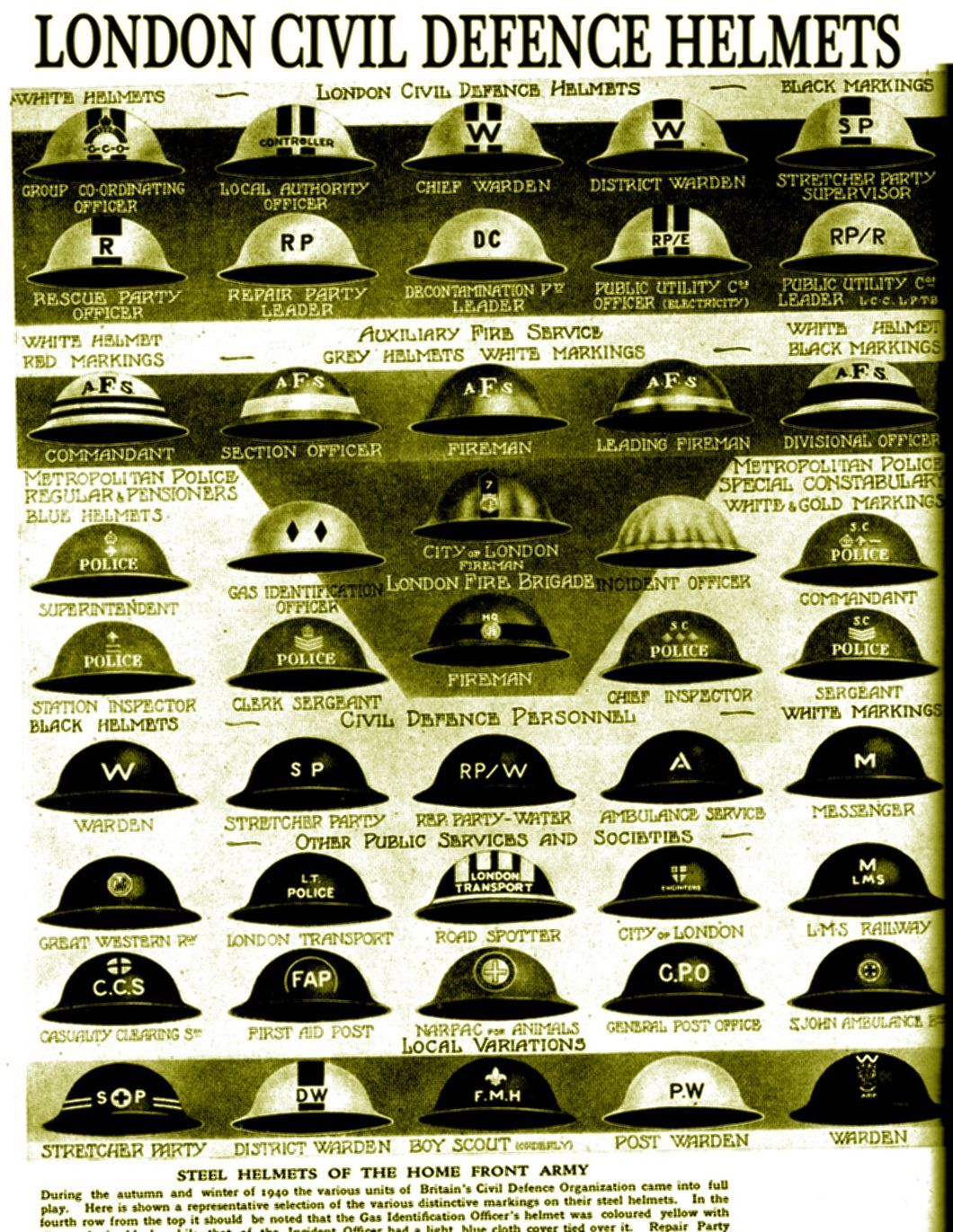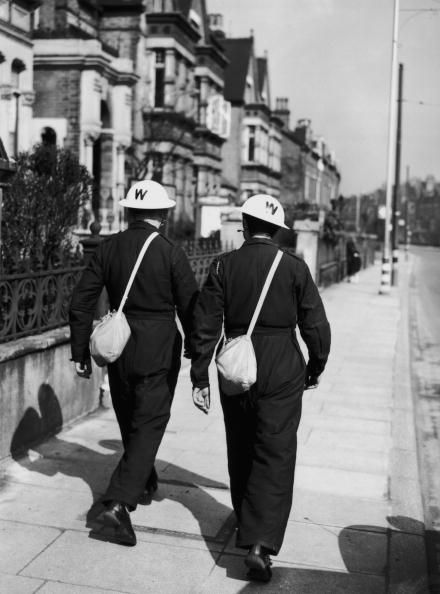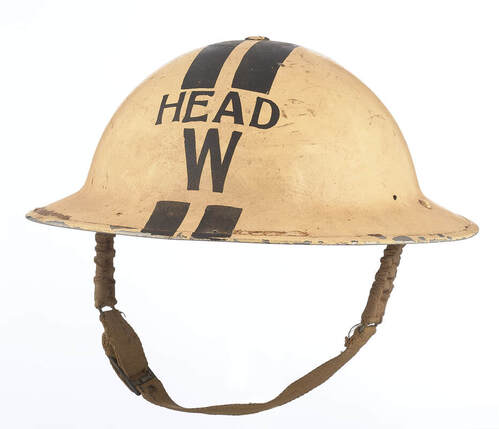|
Adrian Blake, author of Helmets of the Home Front, discusses the development of helmet markings for the Civil Defence General Services during the second world war. The below chart was published in a war-time periodical and details 45 Home Front helmet markings applied in the London area. However, over the years I have seen the best part of 2,000 different helmet markings and I still come across a new marking (to me at least) on average every week. This doesn't mean that this famous chart was incorrect; it simply means that there was a lot more going on than was ever really appreciated, both officially and unofficially. Firstly, for virtually every helmet on this chart, there would have been variants. For instance, taking the example in the bottom right corner – a warden's helmet from St Pancras – this warden would have had a boss, who would have had a boss and so on, all with different markings. Indeed, there's already another standard warden's helmet on the chart (six rows down). Their role would have been identical to Mrs Bottom-Right but her helmet is simply boroughised with a posh multi-coloured water slide transfer (don't call them decals, that's a Yank term) and additional lettering but she was still just a warden, like over a million other brave folk. Up the road in Finchley, Friern Barnet and Stoke Newington, wardens would have the crest of their boroughs applied too, and so would their bosses and their bosses etc (and that’s just four of the 28 boroughs in London). Once you start to include the rest of the country you start to appreciate how many variants for each marking type there could have been. And these are just the official ones.
When helmet markings started, there was the London way and there was everywhere else's way. This London v. non-London situation was addressed mid-war and, it was hoped, would create one single unified, all-encompassing scheme of helmet markings… but, it didn't. To massively oversimplify, London used black bands/stripes over the top of helmets to indicate rank/status and the provinces adopted diamonds. In 1942 diamonds were killed off and bands/stripes became the de facto rank markings and everyone lived happily ever after…but, they didn't. And for every official marking, there were unofficial variants – some Head Wardens weren't happy with the colour and stripes laid down by the Government to represent their Head-ness. They wanted "HEAD" on their helmet presumably to make sure everyone was 100% clear, whilst others added "WARDEN" presumably because they thought a large two-inch black "W" could be misinterpreted. A lot of the more senior rank markings were supposed to be worn by Deputies too so that they could step in and deputise but in some cases, their boss didn't like that. There are documented cases of bosses stating they didn't like their deputies wearing the same helmet markings as they had so they insisted that "DEPUTY" be added to their subordinates' helmets just to show who was in charge (totally missing the point that a Deputy is the boss when the boss isn't there). At least one senior policeman of a very large metropolitan force complained that his opposite number in a much smaller force had the same helmet marking as he wore even though he only commanded a smaller rural force; his argument being that the size of one's force should be reflected in the marking on the helmets (presumably a bigger badge wasn't a solution). Some non-compliances (with national missives) were undertaken at a regional level with the blessing of the Regional Commissioners (each of the 12 Civil Regions had a Regional Commissioner). Areas in the Midlands wore army-style flashes on their helmets and teams on the south coast preferred stripes to diamonds. One region inserted a / between lettering when it wasn't specified whilst another didn't care too much about the colour of the helmets themselves. So, once you take the national variations plus the regional quirks and factor in the "I'm-in-charge" brigade, it becomes easier to understand why there are so many different helmet markings. I've not yet discovered who was first to slap a marking onto the front of their helmet and realistically I'm unlikely to ever find that out (period photos do show markings on helmets in the autumn of 1939 appearing). What I do know is that there were four key communications covering large-scale changes to helmet markings. These communications sometimes took months to agree on before they were actually issued and in some cases draft copies were sent to a handful of regional heads for feedback first. The recipients would then distribute and discuss the proposed changes with their chosen audience. Sometimes these individual bits of feedback were simply clipped together and sent back for consideration whilst other times tables were drawn up to accommodate the individual comments. The four key helmet marking documents covered a lot of detail but to summarise the key helmet-related points: ARP Circular No. 174/1939 – 18/8/1939 (All CD Regions)
London Regional Circular No. 118 – 5/3/40 (London)
Operation and Training Memorandum No. 13 - 29/7/40 (Except London)
Home Security Circular No. 139/1942 - 9/7/42 (All CD Regions) "Standardisation"
Numerous much shorter tweaks and missives were issued as quirks were identified/addressed or on an individual service level.
The fact remains that despite various relatively clear communications red helmets, diamonds, regional preferences, utility company names and general I'm-in-charge pettiness resulted in thousands of marking variations surviving the war. On a more positive note, the vast majority of helmet markings were kept up to date but older markings have started to reappear underneath later over-paints. Paint that has cracked with age reveals different base colours (and previous markings) if you look closely enough and deciphering these can create hours of fun for all the family. Most of the undocumented lettering was applied to helmets worn by factory staff. Many hours can be spent in the pub trying to agree that "WBL" must be "Warden" something or other, but what else starts with "B" and "L"? The chances are it's Wolverhampton Bearings Ltd., a small engineering firm employing 75 staff (making that helmet much rarer than virtually every warden helmet out there). However, despite acknowledging the sheer scale of variations, it's interesting to note how little time and attention appears to be paid to helmet marking rules by today's re-enactors. One sees post after post on social media and forums about the war-time stitching patterns on pockets, the correct number of belt loops, lapel sizes and the correct style of cloth badge backing. Then one sees re-enactors walking around with massive Ws and two very thin black stripes, three inches apart on their helmets (which are sometimes Belgian!); come on guys'n'gals, you can't all be non-compliant, it's time to get your helmets right!
0 Comments
Your comment will be posted after it is approved.
Leave a Reply. |
Please support this website's running costs and keep it advert free
Categories
All
Archives
June 2024
|
|
|
Copyright © 2018–2024
|





 RSS Feed
RSS Feed